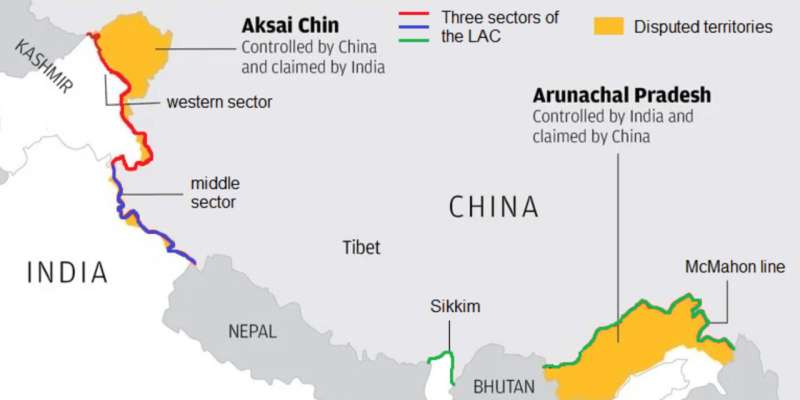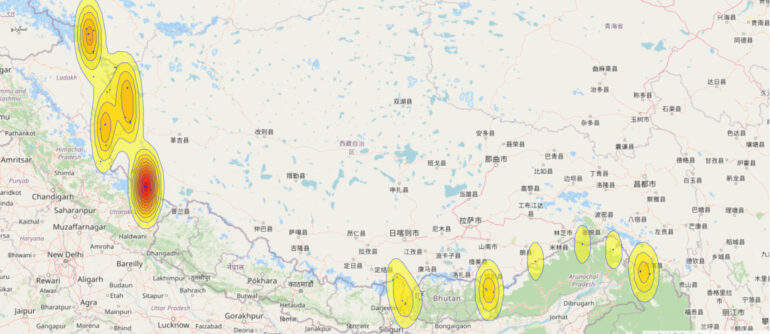Chinese incursions across India’s west and central borders are not independent, random incidents that happen by mistake. Instead, these incursions are part of a strategically planned, coordinated effort in order to gain permanent control of disputed border areas, a new study has found.
Led by Northwestern University, Technical University of Delft in the Netherlands and the Netherlands Defense Academy, the authors assembled a new dataset, compiling information about Chinese incursions into India from 2006 to 2020. Then they used game theory and statistical methods to analyze the data.
The researchers found that conflicts can be separated into two distinct sectors: west/middle (the Aksai Chin region) and east (the Arunachal Pradesh region). While the researchers learned that the number of incursions are generally increasing over time, they concluded that conflicts in the east and middle sectors are part of a coordinated expansionist strategy.
By pinpointing the exact locations lying at the root of the conflict, the researchers believe deterrents could be established in these specific areas to defuse tensions along the entire border.
The study, “Rising tension in the Himalayas: A geospatial analysis of Chinese border incursions into India,” will be published on Nov. 10 in the journal PLOS ONE.
“By studying the number of incursions that occurred in the west and middle sectors over time, it became obvious, statistically, that these incursions are not random,” said Northwestern’s V.S. Subrahmanian, the study’s senior author. “The probability of randomness is very low, which suggests to us that it’s a coordinated effort. When we looked at the eastern sector, however, there is much weaker evidence for coordination. Settling border disputes in specific areas could be an important first step in a step-by-step resolution of the entire conflict.”
A world-renowned expert in AI and security matters, Subrahmanian is the Walter P. Murphy Professor of Computer Science at Northwestern’s McCormick School of Engineering and a Buffett Faculty Fellow at Northwestern’s Buffett Institute for Global Affairs.
Incursions on the rise
The longest disputed border in the world, the India-China boundary has experienced recurring conflicts since 1962. Incursions tend to occur in two distinct regions: Aksai Chin, a region north of Nepal that is controlled by China but claimed by India, and Arunachal Pradesh, a region east of Bhutan that is controlled by India but claimed by China.
To construct their new dataset, the authors compiled publicly available information about border incursions that were well-documented by international media. For the study, the team defined an “incursion” as any movement of Chinese troops across the border—by foot or in vehicles—into areas that are internationally accepted as India’s territory. Then, they plotted each location on a map, identifying 13 hotspots where incursions happen most frequently.
In the 15-year dataset, the researchers noted an average of 7.8 incursions per year. The Indian government’s estimates, however, are much higher at 300 per year.
“Although the Indian government publicizes these numbers, we don’t have the details behind them,” Subrahmanian said. “They might be counting a series of temporally proximate events as several different incursions, whereas we count them all as part of the same one incursion. But when we plotted our data and their data on a graph, the curves still have the same shape. Both curves show that incursions are increasing—but not steadily. They rise and fall, while still trending upward.”

In a 2005 agreement, India and China combined sectors 1 and 2 into the western sector (from Karakoram pass to Mount Gya). The agreement separated sector 3 into a Sikkim sector and an eastern sector (along the state of Arunachal Pradesh on the India side). The middle sector from Mount Gya to the border with Nepal is the least controversial part of the boundary. © PLOS ONE
‘Keep the pot boiling’
Although hotspots occur throughout Aksai Chin and Arunachal Pradesh, the researchers’ game-theory analysis indicates that only the incursions in Aksai Chin are part of a coordinated effort. Building on insights from game theory, the researchers predict that China is trying to establish permanent control over Aksai Chin by allocating more troops for a longer period of time than India.
“China grabs a little bit of territory and then a little bit more until India accepts that it’s Chinese territory,” Subrahmanian said. “There is a saying: ‘Keep the pot boiling but don’t let it boil over.’ China takes small pieces of land, but keeps it under the threshold of where India would counter-attack. But, over time, it becomes a bigger piece of land.”
The finding that China is most interested in acquiring Aksai Chin, Subrahmanian says, supports common knowledge.
“Knowing there are more incursions in the western sector is not a surprise,” he said. “Aksai Chin is a strategic area that China wants to develop, so it’s very critical to them. It’s a vital passageway between China and the Chinese autonomous regions of Tibet and Xinjiang.”
Finding solutions
In a previous paper (published by Nature Humanities and Social Sciences Communications in 2021), Subrahmanian and his collaborators studied when incursions are most likely to occur. They found that China attacks when it feels most vulnerable.
“We found an uptick in incursions when China is experiencing economic stress, such as low consumer confidence,” Subrahmanian said. “We also see upticks when India gets closer to the United States.”
Now that Subrahmanian and his team understand when and where these incursions occur, they next plan to explore how to address them. The study authors believe military interventions should be a last resort. Instead, they suggest bilateral negotiations, developing early warning systems to predict when incursions might occur or bolstering India’s economy in order to challenge China’s economic dominance.
“China’s robust economy results in increased aggression around the world,” Subrahmanian said. “No one wants a war—not just in terms of lives—but in terms of economic ripple effects. It would be an economic tsunami.”
More information:
Rising tension in the Himalayas: A geospatial analysis of Chinese border incursions into India, PLoS ONE (2022). DOI: 10.1371/journal.pone.0274999
Provided by
Northwestern University
Citation:
Chinese incursions into India are increasing and are strategically planned, study finds (2022, November 10)



